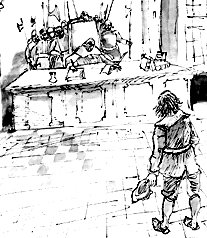Meet the Middle Ages
BackThe Council

The Council governed the town according to the present law. The Council decided who could live in the town, how high the taxes should be, who should be employed as town guards and so on. The Council was also the town’s law-court.
According to the Town Law of Magnus Eriksson, the Council of the Swedish towns should have six chief magistrates and 30 councillors. Only two chief magistrates and ten councillors served at the same time and they served three-year terms. Usually fewer people than this were elected, since few towns were large enough to put forward 36 persons. New members of the Council were elected only when a councillor died or resigned. The councillors chose the new members themselves. The townsmen were told who had been elected at a public meeting on the day of St. Valborg, that is, on May 1.
The Council held its meetings in the Town Hall. When particularly important decisions were to be taken, a public meeting was arranged. All citizens were there and had the right to speak their mind.
The Council collected tax from the citizens. The money was used for repairs of the Town Hall, wages to the officials of the town (chief magistrates, scribes, councillors, inspectors, and town guards) or for local defence. The Council ´s meetings and its decisions were taken down in a special book, a kind of annual called Tänkeboken (the Book of Thoughts). Today four of these are preserved in Sweden: in Stockholm, Kalmar, Arboga and Jönköping. Here, one can find the names of the citizens of these towns. In Germany, these books were called Niederstadtbücher. Many of them still remain.